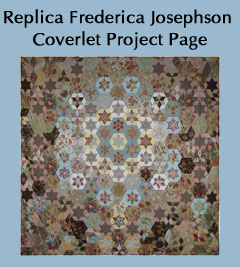QSG Report: Jennifer Corkish Antique Quilt Inspiration
Jennifer Corkish is a noted quilt designer and teacher who
lives in the Southern Highlands of NSW and who
specialises in antique looking quilts. She spoke to us about her inspiration
when designing quilts and the process she follows for reproducing antique
quilts. She was accompanied by five of her students who showed us their quilts,
completed and in progress, demonstrating the variety of modifications to her
quilt patterns that can be made.
 | |
| Jennifer (2nd on left) with her students |
Jennifer told us that she looks at quilt auction and sale websites,
museum collections, magazines, books, quilts brought along to Quilt Study Group
meetings, private quilt collections and old embroideries to inspire her in
designing her quilt patterns. She often takes ideas from different quilts to
come up with a design that is modified in class to meet each of her students’
aims, sewing preferences and fabric choices.
Here are 3 students' variations of one of her designs –
 We were taken through a series of images of antique quilts,
their source details, Jennifer’s designs inspired by those quilts, and then we
were shown 2 to 3 examples of quilts made in her classes from her patterns. Jennifer
carefully explained exactly how each pattern was created and then varied for
each student. Many of her Australian quilt inspirations came from photographs
in Dr. Annette Gero’s books (the Frederica Josephson quilt, the Roebuck quilt,
the Sarah Evans quilt, Elizabeth Hardy’s 1840 quilt, Jessie Wilson’s 1870
Medallion with Heart quilt, Mary Tolman’s 1850s hexagon quilt), Jenny Manning’s
book and Aunt Clara’s quilt from the Powerhouse Museum.
We were taken through a series of images of antique quilts,
their source details, Jennifer’s designs inspired by those quilts, and then we
were shown 2 to 3 examples of quilts made in her classes from her patterns. Jennifer
carefully explained exactly how each pattern was created and then varied for
each student. Many of her Australian quilt inspirations came from photographs
in Dr. Annette Gero’s books (the Frederica Josephson quilt, the Roebuck quilt,
the Sarah Evans quilt, Elizabeth Hardy’s 1840 quilt, Jessie Wilson’s 1870
Medallion with Heart quilt, Mary Tolman’s 1850s hexagon quilt), Jenny Manning’s
book and Aunt Clara’s quilt from the Powerhouse Museum.
Her inspirations are many - patterns on tiles, photographs
of quilts in the Victoria and Albert Museum and
the Beamish Collection in the UK,
and antique quilts she saw at Houston in USA. Jennifer
said she prefers to use ordinary materials to design her quilt patterns – graph
paper, propelling pencil, compass and protractor, but she has been known to use
EQ7 and Photoshop software. Her final statement was apt: “I can’t imagine
living without a needle and thread. That’s why I design, colour, stitch and
teach others to do the same.”
Liz Bonner.










No comments:
Post a Comment